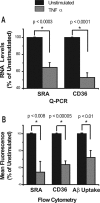Microglial dysfunction and defective beta-amyloid clearance pathways in aging Alzheimer's disease mice
- PMID: 18701698
- PMCID: PMC2597474
- DOI: 10.1523/JNEUROSCI.0616-08.2008
Microglial dysfunction and defective beta-amyloid clearance pathways in aging Alzheimer's disease mice
Abstract
Early microglial accumulation in Alzheimer's disease (AD) delays disease progression by promoting clearance of beta-amyloid (Abeta) before formation of senile plaques. However, persistent Abeta accumulation despite increasing microglial numbers suggests that the ability of microglia to clear Abeta may decrease with age and progression of AD pathology. To determine the effects of aging and Abeta deposition on microglial ability to clear Abeta, we used quantitative PCR to analyze gene expression in freshly isolated adult microglia from 1.5-, 3-, 8-, and 14-month-old transgenic PS1-APP mice, an established mouse model of AD, and from their nontransgenic littermates. We found that microglia from old PS1-APP mice, but not from younger mice, have a twofold to fivefold decrease in expression of the Abeta-binding scavenger receptors scavenger receptor A (SRA), CD36, and RAGE (receptor for advanced-glycosylation endproducts), and the Abeta-degrading enzymes insulysin, neprilysin, and MMP9, compared with their littermate controls. In contrast, PS1-APP microglia had a 2.5-fold increase in the proinflammatory cytokines IL-1beta (interleukin-1beta) and tumor necrosis factor alpha (TNFalpha), suggesting that there is an inverse correlation between cytokine production and Abeta clearance. In support of this possibility, we found that incubation of cultured N9 mouse microglia with TNFalpha decreased the expression of SRA and CD36 and reduced Abeta uptake. Our data indicate that, although early microglial recruitment promotes Abeta clearance and is neuroprotective in AD, as disease progresses, proinflammatory cytokines produced in response to Abeta deposition downregulate genes involved in Abeta clearance and promote Abeta accumulation, therefore contributing to neurodegeneration. Antiinflammatory therapy for AD should take this dichotomous microglial role into consideration.
Figures






References
-
- Alarcón R, Fuenzalida C, Santibáñez M, von Bernhardi R. Expression of scavenger receptors in glial cells. Comparing the adhesion of astrocytes and microglia from neonatal rats to surface-bound beta-amyloid. J Biol Chem. 2005;280:30406–30415. - PubMed
-
- Borchelt DR, Ratovitski T, van Lare J, Lee MK, Gonzales V, Jenkins NA, Copeland NG, Price DL, Sisodia SS. Accelerated amyloid deposition in the brains of transgenic mice coexpressing mutant presenilin 1 and amyloid precursor proteins. Neuron. 1997;19:939–945. - PubMed
-
- Coraci IS, Husemann J, Berman JW, Hulette C, Dufour JH, Campanella GK, Luster AD, Silverstein SC, El-Khoury JB. CD36, a class B scavenger receptor, is expressed on microglia in Alzheimer's disease brains and can mediate production of reactive oxygen species in response to beta-amyloid fibrils. Am J Pathol. 2002;160:101–112. - PMC - PubMed
Publication types
MeSH terms
Substances
Grants and funding
LinkOut - more resources
Full Text Sources
Other Literature Sources
Medical
Molecular Biology Databases
Miscellaneous
